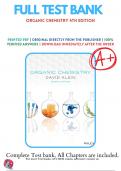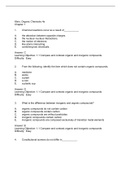Hydration of alkene - Study guides, Class notes & Summaries
Looking for the best study guides, study notes and summaries about Hydration of alkene? On this page you'll find 50 study documents about Hydration of alkene.
All 50 results
Sort by

-
Test Bank for Organic Chemistry, 4th Edition by David R. Klein | 9781119659594|Chapter 1-27 | All Chapters with Answers and Rationals
- Exam (elaborations) • 2151 pages • 2023
- Available in package deal
-
- $24.14
- 30x sold
- + learn more
Test Bank for Organic Chemistry 4e 4th Edition by David R. Klein. ISBN-13: 9594 Full chapters test bank PDF TABLE OF CONTENTS 1 A Review of General Chemistry: Electrons, Bonds, and Molecular Properties 1 1.1 Introduction to Organic Chemistry 2 1.2 The Structural Theory of Matter 3 1.3 Electrons, Bonds, and Lewis Structures 4 1.4 Identifying Formal Charges 7 1.5 Induction and Polar Covalent Bonds 8 1.6 Reading Bond-Line Structures 11 1.7 Atomic Orbitals 14 1.8 Valence Bond Theory 17 1.9 Molecular...

-
Test Bank for Organic Chemistry, 4th Edition by David R. Klein
- Exam (elaborations) • 2149 pages • 2022
-
- $29.99
- 82x sold
- + learn more
Test Bank for Organic Chemistry 4e 4th Edition by David R. Klein. ISBN-13: 9594 Full chapters test bank PDF TABLE OF CONTENTS 1 A Review of General Chemistry: Electrons, Bonds, and Molecular Properties 1 1.1 Introduction to Organic Chemistry 2 1.2 The Structural Theory of Matter 3 1.3 Electrons, Bonds, and Lewis Structures 4 1.4 Identifying Formal Charges 7 1.5 Induction and Polar Covalent Bonds 8 1.6 Reading Bond-Line Structures 11 1.7 Atomic Orbitals 14 1.8 Vale...

-
Organic Chemistry ACS Final Exam Study Questions and Answers with Complete Solution 2024
- Exam (elaborations) • 6 pages • 2024
-
Available in package deal
-
- $13.49
- + learn more
Basicity rules - -strong base: unstable/reactive (ED groups) -weak base: stable (EW groups/more EN/bigger) Chair conformation - -more stable equitorial (slanted) -pointing up/pointing down=cis if both up -elimination: trans and diaxial Newman projection - -gauche: substituent groups adjacent to eachother -grab middle and turn to put in plane Enantiomers - -not superimposable mirror images -same besides stereochemistry Diastereomers - -mirror images but one stereocenter stays and...

-
Chem 210 Exam 4 Questions and Correct Answers, Complete Solution 2024.
- Exam (elaborations) • 9 pages • 2024
-
Available in package deal
-
- $9.99
- + learn more
Chem 210 Exam 4 Questions and Correct Answers, Complete Solution 2024. In order to make an alcohol we can do what types of reactions? addition reactions and oxidation reactions of alcohol What are the two types of addition reactions? hydration of alkene and addition reactions of H2 to C=O We need to figure out if alcohol is a... 1º, 2º, and 3º Ketone addition of H2 to make an alcohol is what type of alcohol? 2º Aldehyde addition of H2 to make an alcohol is what type of alcohol? 1...

-
OAT Organic Chem Reactions Exam Questions with Correct Answers
- Exam (elaborations) • 13 pages • 2024
-
Available in package deal
-
- $14.49
- + learn more
HBr (or HCl, HI) to alkyne, alkene - Answer-add Br and H Markovnikov, rearrangements possible Alkyne + 1 eq HBr = Alkene with Br at most substituted + 2nd eq HBr = Alkane with 2 Br at most substituted hydrohalogenation H3O+ to alkene - Answer-add -OH and H markovnikov, rearrangements possible hydration H+, ROH to epoxide - Answer-add -OR and H markovnikov, rearrangements possible addition of alcohol Br2 or Cl2/ CCl4 to alkyne, alkene - Answer-anti-addition o...

-
Chem 210 – Reactions Questions 100% Solved!!
- Exam (elaborations) • 6 pages • 2024
-
Available in package deal
-
- $11.99
- + learn more
Reagent = Nucleophile Only - ANSWER1° = Sn2 2° = Sn2 3° = Sn1 + E1 (polar medium necessary) Reagent = Strong Nucleophile & Strong Base - ANSWER1° = Sn2 2° = E2 3° = E2 Reagent = Weak Nucleophile and Weak Base - ANSWER1°/2° = No Reaction 3°/resonance stabilized carbocation = Sn1 + E1 (polar medium necessry Reagent = Base Only - ANSWER1° = E2 or Sn2 (if unhindered and no beta-hydrogen with unhindered base) 2° = E2 3° = E2 Examples of Only Nucleophiles - ANSWERCl⁻, ...

-
UNCG CHEM 104 exam 1 (Questions + Answers) Solved
- Exam (elaborations) • 2 pages • 2024
-
- $8.39
- + learn more
When alkanes and cycloalkanes undergo combustion when sufficient oxygen is available, what two products are produced? - ️️carbon dioxide and water What are isomers? - ️️compounds with the same molecular formula but different structures and properties when naming cycloalkanes, the prefix cis- means ___ and trans- means ___? - ️️on the same side; across from The Building block for terpene compounds is the - ️️5-carbon isoprene unit The correct IUPAC name for CH2=CH-CH=CH2 is...

-
Chem 210: Chapter 8 Correct 100%(GRADED A+)
- Exam (elaborations) • 2 pages • 2024
-
- $14.99
- + learn more
Addition - ANSWERA reaction involving an increase in the number of groups attached to the alkene and a decrease in the number Regiochemistry - ANSWERThe orientation of a chemical reaction on an unsymmetrical substrate. In additions to alkenes, the regiochemistry of the addition involves which part of the reagent adds to which end of an unsymmetrical alkene. Regioselective reaction - ANSWERA reaction in which one direction of bond making or bond breaking occurs preferentially over all other...

-
AQA A Level Chemistry- Organic Chemistry questions and answers 100% guaranteed success.
- Exam (elaborations) • 14 pages • 2024
-
- $13.49
- + learn more
AQA A Level Chemistry- Organic Chemistry questions and answers 100% guaranteed success. Empirical formula - ANS.The simplest whole number ratio of atoms of each element present in a compound How to find the empirical formula - ANS.Obtain the mass of each element present in grams (Element % = mass in g = m) Determine the number of moles of each type of atom present Divide the number of moles of each element by the smallest number of moles Co...

-
CHEM 210 Final Exam Study Guide Exam 1 Final Review Questions with Answers
- Exam (elaborations) • 18 pages • 2023
-
Available in package deal
-
- $10.99
- + learn more
What are the differences between aliphatic (including alkanes, alkenes,alkynes and cyclic compounds) aromatic hydrocarbons are. - ALIPHATIC Hydrocarbon: Non-aromatic -Alkanes & CycloAlkanes:single bonds; saturated:Contain only carbon and hydrogen & C-C & C-H single bonds -Alkenes:double bond(s) -Alkynes: triple bond(s) *alkenes and alkynes are unsaturated: at least one C-C double or triple bond(s) AROMATIC Hydrocarbon: benzene ring What is the trend in solubility and boiling point/mel...

How did he do that? By selling his study resources on Stuvia. Try it yourself! Discover all about earning on Stuvia


